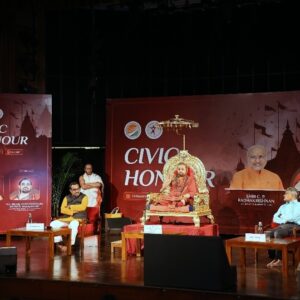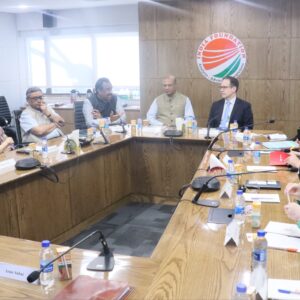One of the most significant aspects of spirituality is that its profoundness can subtly permeate through our lives, creating a deep and integral link between spirituality and life. While placing spirituality into a global perspective is indeed a challenging task, spirituality by its very nature can fit in anywhere and everywhere! Let us link the two by first looking into what spirituality means and entails.
In his book, “A Brief History of Spirituality,” Philip Sheldrake posits that, “…modern spirituality is centred on the deepest values and meanings by which people live… It embraces the idea of an ultimate or an alleged immaterial reality. It envisions an inner path enabling a person to discover the essence of one’s being. In modern times the emphasis is on subjective experience… incorporating personal growth or transformation, usually in a context separate from organised religious institutions.”
Over time, the idea of spirituality seems to be becoming increasingly disassociated from the idea of religion, even though one has its roots in the other. There is a formlessness involved in spirituality which is absolutely personal and inner in nature. It is part of everyone, whether they know it or not. Herein lies its tremendous strength.
Now, let us look into the definition of soft power. The Soft Power 30 report that is brought out by USC Center on Public Diplomacy and the Portland Communications says, “In contrast to the coercive nature of hard power, soft power describes the use of positive attraction and persuasion to achieve foreign policy objectives. Soft power shuns the traditional foreign policy tools of carrot and stick, seeking instead to achieve influence by building networks, communicating compelling narratives, establishing international rules, and drawing on the resources that make a country naturally attractive to the world.”
How has India harnessed its spiritual power as part of its soft power projection and how it should continue to do so? One way of looking at it is that it is a simple case of demand and supply. India has come to be known as a spiritual soft power because across the world, the one thing which is most sought after is peace, and India has always had an abundance of promoters, proponents, patrons, pursuers and practitioners of peace. What is more, peace as a commodity is in ever-increasing demand. Margaret Elizabeth, an Irish lady, met Swami Vivekananda in London in 1895 and thereafter became his disciple and was known as Sister Nivedita. MirraAlfassa, a French lady, who worked and collaborated with Sri Aurobindo, came to be known as “The Mother,” a name given by Sri Aurobindo himself. In the recent past, the Academy award winning actress Julia Roberts embraced Hinduism. Many Indian spiritual saints and mystics have inspired seekers from the West who have found a deep connection with spirituality. The demand of seeking is relevant even today and it is a continuum.
As materialism grows, so does the want for balance, in a seemingly no-win situation. It does not come by the snap of one’s fingers. There are ideals and values that must be first lived, before peace can follow as a by-product. Such ideas are present in India’s spiritual texts and are not locked away, in a secret hidden cave. They are available and accessible to one and all, regardless of caste, creed or colour.
It is not that India has intentionally monopo-lised the “spiritual market”, so what makes spirituality and soft power so synonymous? Expounding on the subject at Roundtable on Spirituality hosted by The Centre for Soft Power Studies, Chennai, on October 21, 2018, Dr. David Frawley stated that India has always been a ‘vishwaguru’ or in today’s parlance a trendsetter, be it in the field of art, education, medicine or literature, to name but a few. He went on to state that, “India’s ancient traditions, largely based on spiritual foundations, have empowered Indians to be pioneers in various ways. And while there has been flexibility as times have changed, there are also many values that have stood the test of time and are still being practiced today as they always have been. Indeed, one of India’s greatest strengths is that not everything in India has changed with time”. As the saying goes, “If it is not broken, do not fix it.”
While Yoga and Ayurveda have permeated the global space in more tangible ways, India’s spirituality has touched international lives in more subtle, albeit undeniable ways. As spiritual values can have no copyright or trademark, across the world we have people living the Indian ways without even knowing that they are Indian. Take for example the practices of mindfulness and meditation. These are no new-age discoveries, but rather age-old means of connecting with oneself, as prescribed by the spiritual masters of India.
Swami Vivekananda, whose 156th birth anniversary India and the globe commemorated on January 12, 2019, emphasised how spirituality is at the core of India’s soft power. “If India is to die,” said Swami Vivekananda, “religion might be wiped off from the face of the earth and with it Truth.” He went on to add, “We have yet something to teach to the world. The raison d’être that this nation has lived on, in spite of hundreds of years of persecution, in spite of nearly a thousand years of foreign rule and foreign oppression… This nation still lives; the raison d’être is, it still holds to God, to the treasure house of religion and spirituality” (Narayanaswamy, 2012).
His words remains true to date and permeate the minds of global citizens. In contemporary times, worldwide academia slowly but surely acknowledges India’s contribution to the world through the prism of spirituality. An American Journal, Scientific American, has credited ancient Indians for the understanding of the life principle and their understanding of yogic science. The journal noted the contribution of Pranayama as well (André, 2019). “Recommendations for how to modulate breathing and influence health and mind appeared centuries ago as well. Pranayama (breath retention) yoga was the first doctrine to build a theory around respiratory control, holding that controlled breathing was a way to increase longevity.”
Therefore, it makes a compelling case for India to strengthen its soft power diplomacy by showcasing its spiritual roots. On a visit to Mongolia, Indian Prime Minister Narendra Modi, used the term “spiritual diplomacy” for the first time. Addressing the Great Hural, the Mongolian Parliament, the Prime Minister affirmed (Press Information Bureau, 2015), “I bring the greetings of your 1.25 billion spiritual neighbours. There is no higher form of a relationship; no bonds more sacred than this.” It is precisely for this reason that India can take a giant leap vis-à-vis soft power diplomacy by positing its greatest contribution, spirituality, to the world.
The idea of a civilisational heritage and spirituality has entered the Indian foreign policy lexicon in several ways. DayaThussu has also gone on to term this as the ‘Indic Civilisation’ (Kishwar, 2018). This has also manifested as sanskritievamsabhyata (cultural and civilisational links), as one of the main pillars of the Panchamritprinciples outlined by the Indian government in April 2015 (Kishwar, 2018).
The Indian leadership, under the present Government, has used spiritual linkages to enhance relations with other countries. For instance, in August 2014, during his visit to Nepal, Prime Minister Narendra Modi referred to Nepal as the “land of Sita and Janak,” and as “the country of Buddha’s birth,” thereby bringing millennia old religious connections into the present day. As an addendum, India has also mooted, through its Ministry of Tourism, the Buddhist Circuit that will enable India’s civilisational connect with its neighbours. Buddhism’s presence in the foreign policy discourse has been promoted by a number of spiritual organisations, think tanks, individuals etc. The Buddhist strand of thought and religion originated in India and so it makes absolute sense for India to promote Buddhist diplomacy. With the advent of the Buddhist Tourist Circuit, India is home to numerous sites of importance to the Buddhist faith, such as Bodh Gaya, Sarnath, and Nalanda. India is also the place where the world’s largest spiritual gathering Kumbh Mela takes place in Prayagraj, Uttar Pradesh. In 2013, Harvard University researchers even came to Prayagraj to study the Kumbh Mela, from the prism of logistics, economics and design.
Diana L. Eck, Professor of Comparative Religion and Indian Studies at the Harvard University who was part of that research has beautifully enunciated Hinduism. She says, “Hinduism is an imaginative, an ‘image-making’ religious tradition in which the sacred is seen as present in the visible world – the world we see in multiple images and deities, in sacred places, and in people. The notion of darsan calls our attention, as students of Hinduism, to the fact that India is a visual and visionary culture, one in which the eyes have a prominent role in the apprehension of the sacred. For most ordinary Hindus, the notion of the divine as ‘invisible’ would be foreign indeed. God is eminently visible although human beings have not always had the refinement of sight to see. Furthermore, the divine is visible not only in temple and shrine, but also in the whole continuum of life-in nature, in people, in birth and growth and death.”
It is pertinent to note that spirituality has found its way across the globe, earning India its ‘soft power’ status much before the term itself was coined. While the US exported MTV, Coca Cola and McDonalds, India exported spirituality and its values across the globe.
We, as a nation, are at a very critical juncture with respect to the use and play of soft power in global politics. China has left no stone unturned in ramping up its soft power assets and deploying them to serve its said objectives. It intends to have at least 1000 Confucius Institutes by 2020, across the world. In this context the time is ripe for India to know and leverage the spiritual impact that the nation has had on the world. This will no doubt enable India’s standing in the global power structures and serve its interests.
Spirituality is not a business to be run on profit and loss basis. It is much beyond that and it has permeated the globe for eons and it will continue to do so. In the world outside today, there have been several ambassadors like Ramakrishna Paramhansa, Swami Vivekananda, Aurobindo, Kabir, Guru Ravidas, Ramana Maharishi etc. who have enabled innumerous people abroad to embrace spirituality and transform their lives. Christopher Quilkey from Australia, who is also a Member of the Editorial Board of the Mountain Path Magazine said at the recently held Conference on Soft Power in New Delhi, organised by India Foundation, in December 2018, “Be assured, the power of the principle that envelops India, that is spirituality, is slowly pervading the group consciousness of this world.”
References:
Bibliography
- “Spirituality.” 2019. In Wikipedia. https://en.wikipedia.org/w/index.php?title=Spirituality&oldid=876751701.
- Sheldrake, Philip. 2007. A Brief History of Spirituality. 1 edition. Malden, MA: Wiley-Blackwell.
- “Soft Power.” 2019. In Wikipedia. https://en.wikipedia.org/w/index.php?title=Soft_power&oldid=878441564.
- Breslin, Shaun. 2011. “The Soft Notion of China’s ‘Soft Power.’” Report. London: Chatham House.
http://www.chathamhouse.org.uk/publications/papers/view/-/id/1001/.
- Narayanaswamy, Ramnath. 2012. “Spirituality Is India’s Soft Power.” Deccan Herald, August 8, 2012.
https://www.deccanherald.com/content/270207/spirituality-indias-soft-power.html.
- André, Christophe. 2019. “Proper Breathing Brings Better Health.” Scientific American. January 15, 2019.
https://www.scientificamerican.com/article/proper-breathing-brings-better-health/.
- Press Informationa Bureau. 2015. “Text of Remarks by Prime Minister in the Mongolian Parliament.” May 17, 2015.
http://pib.nic.in/newsite/PrintRelease.aspx?relid=121802.
- Kishwar, Shantanu. 2018 “The Rising Role of Buddhism in India’s Soft Power Strategy.” ORF (blog). Accessed January 16, 2019.
https://www.orfonline.org/research/the-rising-role-of-buddhism-in-indias-soft-power-strategy/.
- PTI. 2014. “Narendra Modi Wins Hearts and Minds by Using Nepali Language in Speech,” March 8, 2014.
https://economictimes.indiatimes.com/news/politics-and-nation/narendra-modi-wins-hearts-and-minds-by-using-nepali-language-in-speech/articleshow/39558089.cms.
(Mr. Sudarshan Ramabadran is a Senior Research Fellow and Administrative Head,
Centre for Soft Power, India Foundation. Views expressed by the author are personal.)
(This article is carried in the print edition of March-April 2019 issue of India Foundation Journal.)



